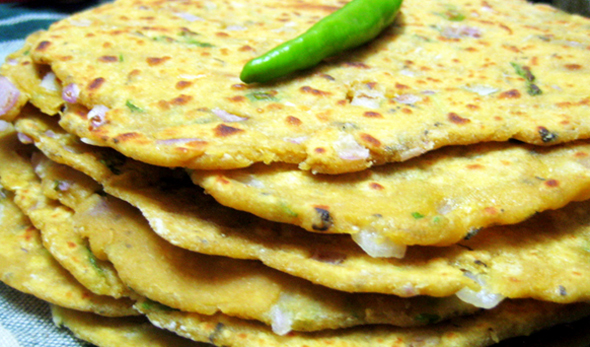Mama’s Punjabi Recipes- Missi Roti (SPICY MIXED FLOUR FLATBREAD)
No, the name of this bread does not mean that you are “missing” the roti! It actually means a roti made of mixed flours and added spices and herbs like methi (fenugreek), dhania (coriander seeds) and even anaar danna (crushed pomegranate seeds). It’s a special flatbread that is served in many Indian restaurants with daal makhani and jeera aloo.
A Rajasthani variety of missi roti is made with crushed green chilies, black salt and ginger. Another type is made with wheat flour, moong dal, chili powder, garam masala, ground cumin, coriander powder, ground turmeric, salt, oil.
But the traditional Punjabi style missi roti only uses a mixture of atta (wheat flour) and besan (gram or chickpea flour) with some spices to form an unleavened bread on a tava (flat skillet). The other necessary ingredient is oil so that the two sides of the roti can become crispy and flaky.
Besan is another very popular staple flour in India, made of dried chickpeas. It is used in a variety of dishes, most commonly to make the popular pakodas (fried fritters). Besan is high in carbohydrates, is gluten-free and has a higher proportion of protein that other flours. Mixed with water, it can be used as a facial exfoliant or scrub or to replace eggs in vegan cooking.
In the heat of the Punjab, this is the bread that can easily be eaten with a dollop of homemade butter or just plain yogurt or with a cool glass of lassi (buttermilk) sitting under the shade of a tree on a charpai (jute string cot).
Ingredients:
2 cups atta (unbleached wheat flour). Makes 10 rotis
1 cup besan (gram flour)
1 tbsp tael (vegetable oil) – olive oil if you prefer
2 cups pani (water)
1 small piyaaz (onion) – peeled and cubed
Spices: namak (salt), mirch (red pepper), dhania (coriander), amchoor (dried green mango powder) and anaar danna (pomegranate seed powder)
Tael (oil – use olive oil) for cooking
Directions:
1. Pour the atta and besan in a bowl and mix well, blending in the spices. For best taste, freshly crush the coriander seeds in a mortar with a pestle or in a mixer and add to the flour mixture.
2. Slowly pour the water in while kneading the dough, adding the oil to make it softer, till it becomes a nice, tender but firm ball. Dab the surface of the ball with a little water to keep it moist, cover the bowl and set aside. If the dough is too hard, the roti will also be hard. Do not use any baking soda.
3. Cover the bowl and set the dough aside to become softer.
4. After an hour uncover the bowl and pinch off a portion of the dough and make into a 2 inch round ball.
5. Pour a little dry flour on the counter and roll the ball in it to coat it. Now use a velna (rolling pin) to roll the ball into a nice round, flat pancake, about 1/8 inch thick.
6. Place the tava on the stove and heat on medium and coat with a small dab of oil. Now carefully place the flattened dough on the tava. Once the dough starts to show some bubbles, then turn it over and coat with a little oil. Let the other side also cook till bubbles appear. Now flip the dough again and when you see small brown spots, gently press the top with a flat spatula.
7. Take the roti off the tava and keep on the side. Both sides should be a little crispy. If it is overcooked it will show large dark spots. Cover with a clean soft cloth to keep warm; do not place in a plate right away as the roti will shed some water vapor.
8. Now repeat the process till the rest of the rotis are made and the dough is finished.
people prefer to eat it cold, so refrigerate for an hour or two before serving.
MAMA’S TIP OF THE WEEK
FOR SOFTER PAKODAS AND FRIED FOODS, DON’T COOK ON LOW HEAT
One of the favorite simple snacks for many people is besan de pakode or fried fritters. These are supposed to be soft but firm, not oily or fluffy (which indicates the use of baking soda in the dough). Most people don’t make them at home anymore, preferring to buy them instead. Some restaurants make really crunchy pakode which are dry and hard to digest. This is usually because they are cooked for too long over low heat. For proper texture, cook over medium-high heat for a short time till the pakode are lightly brown.
Shakuntla Malhotra is a skilled cook of Punjabi dishes made in the old-fashioned style that she learnt as a young woman in her ancestral home in Lyallpur, India before it became part of Pakistan after the Partition in 1947. People have often admired her cooking for its simplicity and taste that comes with each mouthful. Even in her mid-eighties, she continues to cook daily and agreed to share some of her delectable Punjabi recipes.


